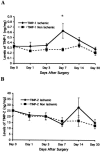Temporal exposure of cryptic collagen epitopes within ischemic muscle during hindlimb reperfusion
- PMID: 16251419
- PMCID: PMC1603793
- DOI: 10.1016/S0002-9440(10)61222-9
Temporal exposure of cryptic collagen epitopes within ischemic muscle during hindlimb reperfusion
Abstract
Chronic limb-threatening ischemia is a devastating disease with limited surgical options. However, inducing controlled angiogenesis and enhancing reperfusion holds therapeutic promise. To gain a better understanding of the mechanisms that contribute to limb reperfusion, we examined the temporal biochemical and structural changes occurring within the extracellular matrix of ischemic skeletal muscle. Both the latent and active forms of MMP-2 and -9 significantly increased during the active phase of limb reperfusion. Moreover, small but significant alterations in tissue inhibitors of metalloproteinase levels also occurred during a similar time course, consistent with a net increase in extracellular matrix remodeling. This temporal increase in MMP activity coincided with enhanced exposure of the unique HU177 cryptic collagen epitope. Although the HUIV26 cryptic collagen epitope has been implicated in angiogenesis, little is known concerning such epitopes within ischemic muscle tissue. Here, we provide the first evidence that a functionally distinct cryptic collagen epitope (HU177) is temporally exposed in ischemic muscle tissue during the active phase of reperfusion. Interestingly, the exposure of the HU177 epitope was greatly diminished in MMP-9 null mice, corresponding with significantly reduced limb reperfusion. Therefore, the regulated exposure of a unique cryptic collagen epitope within ischemic muscle suggests an important role for collagen remodeling during the active phase of ischemic limb reperfusion.
Figures






Similar articles
-
Disruption of endothelial cell interactions with the novel HU177 cryptic collagen epitope inhibits angiogenesis.Clin Cancer Res. 2007 May 15;13(10):3068-78. doi: 10.1158/1078-0432.CCR-06-2342. Clin Cancer Res. 2007. PMID: 17505010
-
Myocardial protection from ischemia/reperfusion injury by targeted deletion of matrix metalloproteinase-9.Cardiovasc Res. 2002 Jun;54(3):549-58. doi: 10.1016/s0008-6363(02)00254-7. Cardiovasc Res. 2002. PMID: 12031700
-
Basement membrane remodeling in skeletal muscles of patients with limb ischemia involves regulation of matrix metalloproteinases and tissue inhibitor of matrix metalloproteinases.J Vasc Res. 2007;44(3):202-13. doi: 10.1159/000100376. Epub 2007 Feb 27. J Vasc Res. 2007. PMID: 17337906
-
Experimental hindlimb ischemia leads to neutrophil-mediated increases in gastrocnemius MMP-2 and -9 activity: a potential mechanism for ischemia induced MMP activation.J Surg Res. 2004 Apr;117(2):249-54. doi: 10.1016/j.jss.2003.09.009. J Surg Res. 2004. PMID: 15047130
-
Matrix metalloproteinase-9-dependent exposure of a cryptic migratory control site in collagen is required before retinal angiogenesis.Am J Pathol. 2002 Oct;161(4):1429-37. doi: 10.1016/S0002-9440(10)64418-5. Am J Pathol. 2002. PMID: 12368215 Free PMC article.
Cited by
-
BMP9 Crosstalk with the Hippo Pathway Regulates Endothelial Cell Matricellular and Chemokine Responses.PLoS One. 2015 Apr 24;10(4):e0122892. doi: 10.1371/journal.pone.0122892. eCollection 2015. PLoS One. 2015. PMID: 25909848 Free PMC article.
-
Changes in cardiac resident fibroblast physiology and phenotype in aging.Am J Physiol Heart Circ Physiol. 2018 Oct 1;315(4):H745-H755. doi: 10.1152/ajpheart.00237.2018. Epub 2018 Jun 15. Am J Physiol Heart Circ Physiol. 2018. PMID: 29906228 Free PMC article. Review.
-
Enzymatically-responsive pro-angiogenic peptide-releasing poly(ethylene glycol) hydrogels promote vascularization in vivo.J Control Release. 2015 Nov 10;217:191-201. doi: 10.1016/j.jconrel.2015.09.005. Epub 2015 Sep 11. J Control Release. 2015. PMID: 26365781 Free PMC article.
-
A review of the pathophysiology and potential biomarkers for peripheral artery disease.Int J Mol Sci. 2015 May 18;16(5):11294-322. doi: 10.3390/ijms160511294. Int J Mol Sci. 2015. PMID: 25993296 Free PMC article. Review.
-
Superficial spreading and nodular melanoma are distinct biological entities: a challenge to the linear progression model.Melanoma Res. 2012 Feb;22(1):1-8. doi: 10.1097/CMR.0b013e32834e6aa0. Melanoma Res. 2012. PMID: 22108608 Free PMC article. Review.
References
-
- Lewis CD. Peripheral arterial disease of the lower extremity. J Cardiovasc Nurs. 2001:45–63. - PubMed
-
- Carmeliet P. Mechanisms of angiogenesis and arteriogenesis. Nat Med. 2000;6:389–395. - PubMed
-
- Risau W. Mechanisms of angiogenesis. Nature. 1997;386:671–674. - PubMed
-
- Hershey JC, Baskin EP, Glass JD, Hartman HA, Gilberto DB, Rogers IT, Cook JJ. Revascularization in the rabbit hindlimb: dissociation between capillary sprouting and arteriogenesis. Cardiovasc Res. 2001;49:618–625. - PubMed
-
- Heilmann C, Beyersdorf F, Lutter G. Collateral growth: cells arrive at the construction site. Cardiovasc Surg. 2002;10:570–578. - PubMed
Publication types
MeSH terms
Substances
Grants and funding
LinkOut - more resources
Full Text Sources
Miscellaneous

